What is the Internet of Things or IoT as it’s also called? An overview of IoT definitions and related terms with an easy introduction to how IoT works with facts and characteristics.
Attempts to define what the Internet of Things is and means exist since the term was first coined and even before that since the notion of a connected reality that includes the physical world (things) isn’t new at all.
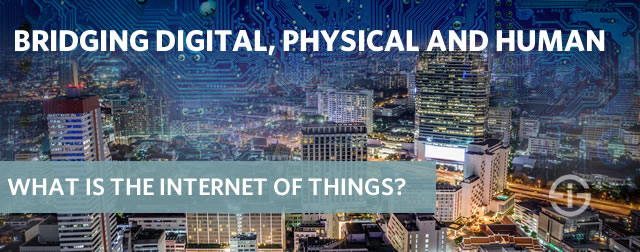
There is no universal definition of IoT yet and no one can see everything that the Internet of Things will effectively mean on the longer term. One IoT definition would be that it’s certainly an umbrella term for a broad range of technologies, applications and use cases.
From a broader perspective, the IoT can be perceived as a vision with technological and societal implications. (ITU)
These IoT use cases are enabled by the connection of objects and devices which can be uniquely addressed via Internet technologies (IP address) and capture, transmit and receive data, depending on their purpose.
And of course it’s all about this data and what it allows to realize. When we say data inevitably we also say that all technologies and systems in an IoT scope are related with turning this data into knowledge, actions and decisions (DIKW).
Often we don’t know the rich variety of technologies underneath the IoT umbrella and many other terms such as the Industrial Internet of Things (also known as IIoT), the Internet of Services, Consumer IoT (CioT), Industry 4.0, the Internet of Medical Things, the Internet of Everything (IoE) and many more terms, all with their acronyms.
It’s clear that none of them stand on their own and technologies such as edge computing, in combination with cloud computing and on-premises, big data analytics, artificial intelligence and machine learning and far more are involved. Precisely because of this data indeed.
IoT has its own technology stack that starts from connecting things, capturing the data and communicating it and ends with applications.
Data is inherently dumb: when deciding what we do with it we also must prioritize which data, turned into information, is most critical and how we combine data from different sources and in different forms; a matter of good data management practices.
IoT gateways and IoT platforms play an important role in that stack as do many network standards with ever more wireless connectivity options. Yet, back to our IoT definitions first.
Defining IoT as the next stage of the Internet
There are many IoT definitions. It just depends on how you look at it: the application perspective, the technological perspective, the industry context, the benefits, etc.
We could also define IoT as the next stage in the Internet as some do, whereby things and objects with sensors and actuators are connected to the Internet so they can gather, send and get data, leading to smarter solutions and in some cases also act upon data.
That’s how most of us see it. Wearables are connected and enable us to send and receive data, vehicles get connected, home appliances, industrial assets, street lights, smart building assets, you name it. However, that’s just part of the story that looks at the what, rather than the why and how. If you look at the Internet of Things a bit more in depth you quickly notice that it’s part of something bigger as we’ll cover.
Our IoT definition: a network of connected devices with 1) unique identifiers in the form of an IP address which 2) have embedded technologies or are equipped with technologies that enable them to sense, gather data and communicate about the environment in which they reside and/or themselves.
The potential and reality of IoT does not lie in the ability to connect IoT-enabled objects nor in the embedded technologies and electronics such as sensors, actuators and connectivity capabilities. It resides in the ways the IoT is used to leverage the insights from data, automate, digitize, digitalize, optimize and in more mature stages transform processes, business models and even industries in a scope of digital transformation.
Note there is no universally agreed IoT definition although there is an ongoing project to build one and bodies such as the ITU (International Telecommunication Union) have done recommendations (more below).
IoT definitions: what IoT is not
As said, it is not that easy to define IoT because it has become an umbrella term for many realities which, in the end, have little in common, depending on how you look at it. That’s why, as you will see in the definitions below there are several approaches and views.
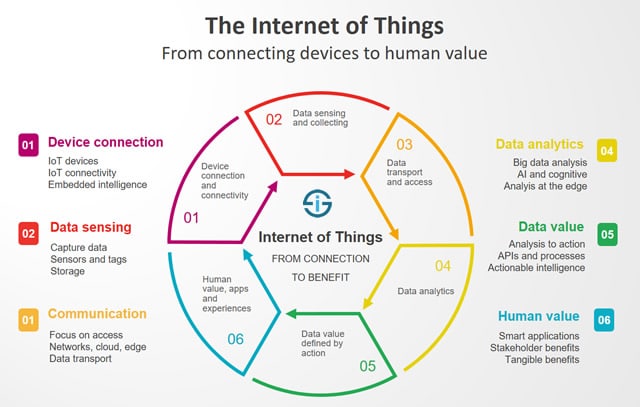
Not every connected device is part of the Internet of Things
We have been connecting devices and ‘things’ to the Internet and other networks since quite some time. Phenomena such as M2M (machine-to-machine) and more which we’ll cover aren’t new at all. This doesn’t mean by definition that all these ‘connected’ devices nor their inherent capacities are part of what we know as the Internet of Things.
The Internet of Things enables a smarter bridging of digital, physical and human spheres by adding data capture and communication capacities to objects in a secure way to a networked environment.
Connected devices and the networks we use to achieve specific goals with them are at least two decades old, albeit for specific and more ‘simple’ purposes.
Think about how we have been using RFID tags in logistics, manufacturing and warehousing for years to track items (and NFC or near field communications).
It’s not a coincidence that in these same markets (with manufacturing being the leading one), Internet of Things investments are the highest.
Other systems of connected devices that have existed since long before the Internet of Things as we know it today include machine-to-machine (M2M) networks, ATMs, point of sales systems and so forth.
In other words: not all connected devices are IoT-connected devices but all IoT-connected devices are connected devices. Moreover in the Internet of Things we use the Internet Protocol (IP), more specifically IPv6. So, we only speak about the Internet of Things when ‘things’ (or better: endpoints) are uniquely addressable, using an IP address or Uniform Resource Identifier.
The Internet of Things is not a thing
Although we speak about the Internet of Things as if it were a thing it is many things but also an ecosystem of inevitably related processes and other technologies from the perspective of a goal within a specific use case.
It is not just about the connected devices but also about the hardware, software, connectivity and communication protocols, middleware and so much more to create Internet of Things solutions as mentioned. And it’s also about many processes and technologies (big data, analytics, cloud computing, edge computing and fog computing, IoT platform software, IoT gateways etc.) which are needed to do something with the Internet of Things.
It is clear that when we speak about the Internet of Things in the context of for instance fitness trackers this has little in common with the Internet of Things as it’s used in industrial settings such as smart supply chain management, manufacturing or connected logistics, to give a few Industrial Internet examples or with the way IoT is used in smart offices or smart cities. That’s why people started segmenting various Internet of Things segments or started looking more at the various use cases as you can read below.
Seven IoT characteristics
You can define IoT by looking at the various characteristics in the broader context. We see all of these characteristics coming back in most Internet of Things definitions out there (further below is an overview with some of these IoT definitions).
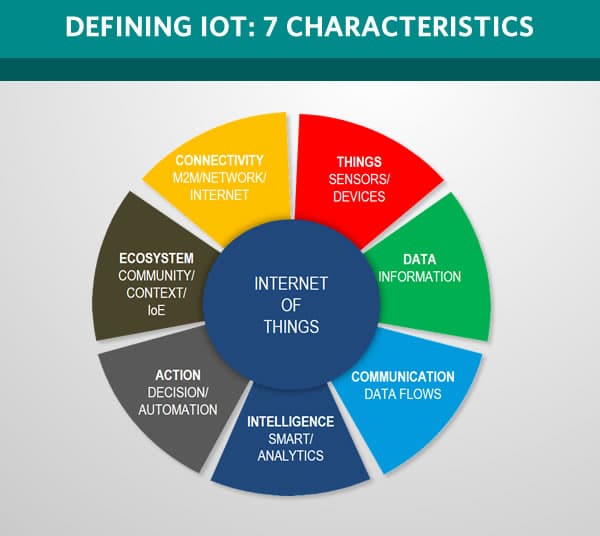
There are 7 crucial IoT characteristics:
- Connectivity. This doesn’t need too much further explanation. With everything going on in IoT devices and hardware, with sensors and other electronics and connected hardware and control systems there needs to be a connection between various levels.
- Things. Anything that can be tagged or connected as such as it’s designed to be connected. From sensors and household appliances to tagged livestock. Devices can contain sensors or sensing materials can be attached to devices and items.
- Data. Data is the glue of the Internet of Things, the first step towards action and intelligence.
- Communication. Devices get connected so they can communicate data and this data can be analyzed. Communication can occur over short distances or over a long range to very long range. Examples: Wi-Fi, LPWA network technologies such as LoRa or NB-IoT.
- Intelligence. The aspect of intelligence as in the sensing capabilities in IoT devices and the intelligence gathered from big data analytics (also artificial intelligence).
- Action. The consequence of intelligence. This can be manual action, action based upon debates regarding phenomena (for instance in smart factory decisions) and automation, often the most important piece.
- Ecosystem. The place of the Internet of Things from a perspective of other technologies, communities, goals and the picture in which the Internet of Things fits. The Internet of Everything dimension, the platform dimension and the need for solid partnerships.
IoT definitions and the challenge of IoT terminology evolutions
In the early days (and in a sense for many it still is early days) when people started speaking about the Internet of Things, that was the universal term.
However, as said the term Internet of Things was used in so many contexts, from cheap consumer devices to high-end solutions in industrial environments and for so many use cases that people started distinguishing and birth was given to terms such as Industrial IoT or IIoT, Consumer IoT or CIoT, IoE (Internet of Everything) and literally dozens more terms and acronyms.
While the reasons to do so were valid, de facto today people simply speak about IoT again, whether we like it or not. Below are a few of these various types of IoT. Some, such as the Internet of Everything or IoE, “invented” by Cisco, are fully dropped now by the people who coined them. IoT it is and will be for quite some time. Yet, new ones keep popping up. Do the test and search our site for terms such as IoRT, IoTDS, IoTS, IoHT, IoMT, IoTDS or IoTSP to cite a few of which we explain some below.
Defining IoT with a consumer part and an industrial/business segment
The first distinction people started to make was between a consumer IoT and an Internet of Things for industrial applications or Industrial IoT as a way to distinguish between many types of IoT use cases and applications. Yet, as said and as with all terminology there were certainly overlaps in the definitions of these forms of IoT.
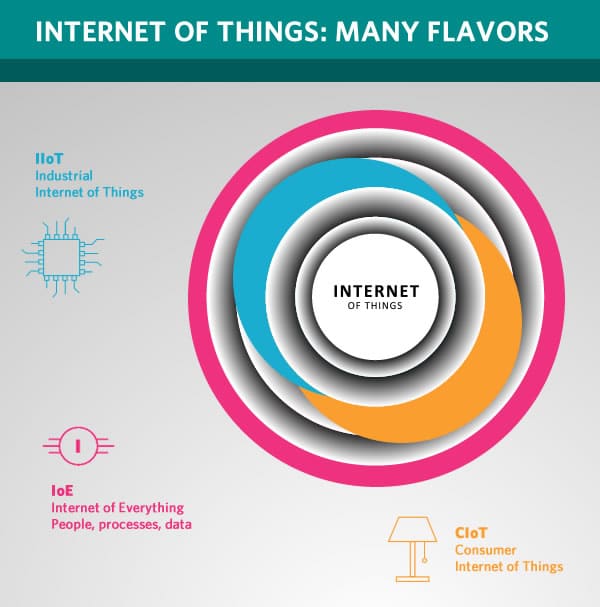
This is why some organizations and individuals, for instance, rather talk about the Internet of Everything, while others opt to drop the term IoT alltogether and mention it in terms of specific use cases and contexts such as smart cities, smart metering, smart buildings, smart office, smart wearables, Industrial Internet or smart homes, all of course with their own meaning and, again, with more subdivisions.
Consumer IoT definition (CIoT)
The Consumer Internet of Things is what almost everybody knows. It’s what the media talk about most.
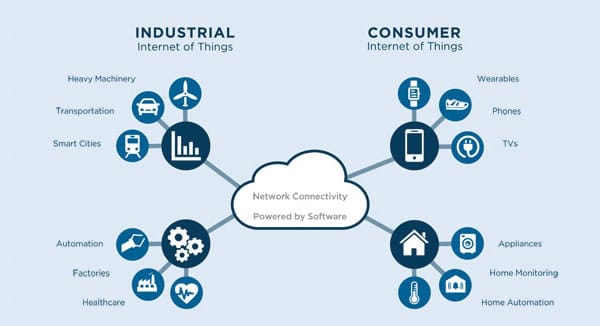
The Consumer Internet of Things or CIoT is where you will find applications and use cases to track your personal ‘assets’ (asset tracking), from your pet to your skateboard. Or where you will find the connected ‘smart appliances’ such as connected refrigerators, washing machines, light bulbs, etc.
Also wearables for consumer use (wearables are also used in healthcare and in factories, to name just two) and all sorts of consumer electronics such as smart wristwear belong to this category, along with all sorts of smart home appliances like thermostats or connected parking door openers.
The applications get better and smarter. They also get more independent from other devices such as smartphones. This is certainly the case with smart wearables.
A simple definition of the Consumer Internet of Things is all we need: the Internet of Things as it’s used for consumer applications and consumer-oriented services.
Typically, in Consumer IoT, data volumes and data communication needs are low and limited. That’s why there are many technologies of which some are specifically designed for consumer applications, ranging from smart home connectivity standards to special operating systems for wearables.
IIoT definition
The Industrial Internet of Things or IIoT describes typical industry use cases across a range of sectors. Two examples of Industrial IoT use cases: predictive maintenance and asset management. Some people see the Industrial Internet of Things more in a context of ‘heavy’ industries like manufacturing or utilities. But it is also used for use cases in, for example smart cities and building management.
If we look at it as a sort of ‘Business Internet of Things’ it is clear that there are some overlaps with the Consumer Internet of Things. For instance: if you have a smart thermostat and smart energy consumption meter in your house they are on one hand consumer applications because they are for personal usage.
But from the perspective of the company that uses it to send you invoices and to help optimize energy consumption it is a business matter (e.g., ‘smart grid‘). So, the terms are not that good but that’s how it is and it’s better to look at use cases than at these broad categories because just as there are many different applications in the Consumer Internet of Things, there are also many in IIoT and some are hard to compare. Most industrial IoT applications relate to the digital transformation of manufacturing or to the rise of smart industry though.
The longer IoT definition
We gave our IoT definition earlier but now we expand it to a description of IoT in a broader perspective.
Definition of IoT as a foundation and enabler
IoT is an umbrella term which describes a multi-faceted foundation for a range of applications and goals which are enabled through the connection of items (devices, sensors, tagged beings), equipped with data capture and communication capacities, uniquely identifiable and connected, in order to transmit and/or received data for a clear human, business or societal purpose.
The Internet of Things enables a smarter bridging of digital, physical and human spheres by adding these capacities in a secure way to a networked environment.
The Internet of Things is an additional layer of information, interaction, transaction and action which is added to the Internet thanks to devices, equipped with data sensing, analysis and communication capabilities, using Internet protocols.
Using Internet technologies such as IP, the connection of the capacities of IoT-enabled devices and applications fit in a broader ecosystem of IoT-specific protocols, standards and architectures, data analysis, information management, communication and network technologies; specific technologies depending on the use case, automation, processes and people, with an insights-driven societal, industrial, business and/or human purpose in mind.
The key components of an IoT deployment from a high-end perspective are:
- The IoT endpoint environment (sensing and data capture, in some cases analysis at the edge).
- Connectivity within the endpoint environment where data from sensors and actuators (transducers) are transmitted and received in hubs.
- Connection with the cloud and applications, in some cases middleware, called IoT platforms.
- The actual outcomes in the form of the end customer application and/or process integration/automation and/or services.
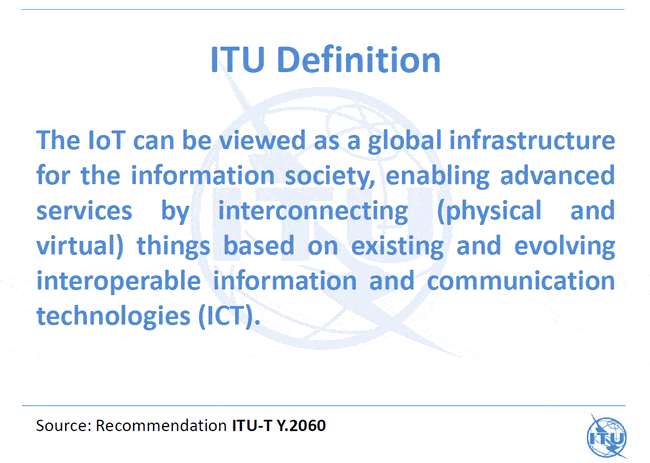
Defining IoT using information, interaction, transaction and action
The most simple and straightforward IoT definition as we mentioned it starts from looking at the essence of the Internet which is a global network, characterized by information, interaction and transaction. Communication is part of interaction, with information as its enabler.
Originally, it presented information and linked information, obviously with a human purpose. Soon interaction and transaction, human and automated, were added, with the end goal remaining human but with an additional touch of processes. The glue of these many forms of interaction, transaction, communication, processes and so forth remained information which is added, created, shared, consumed and used to fulfill a task. With the Internet of Things another layer is added but in the end it again is about information and how it is used for human goals and automation, with a focus on moving from data to actionable intelligence and in the end transaction, interaction etc. So, in the end it’s all about data and what we do with it.
List of Internet of Things definitions
IoT definition: IoT as the rebranded and renewed M2M
In the Summer of 2017 we had an interview with Nicolas Windpassinger (Schneider Electric’s EcoXpert program manager) who was about to release a book on the Internet of Things, entitled ‘Digitize or Die‘. In his IoT book, Windpassinger looks at technologies, strategies and the transformational impact of the Internet of Things.
The Internet of Things definition he gives in ‘Digitize or Die’ is as follows: the Internet of Things is “a global infrastructure for the information society, enabling advanced services by interconnecting (physical and virtual) things based on existing and evolving interoperable information and communication technologies“.
If you’ve been learning or reading about IoT you might recognize that definition. It is indeed the Internet of Things definition as it was published in Recommendation ITU-T Y.2060, which goes back to 2012.
That’s quite some time after Kevin Ashton coined the term Internet of Things (1999) but just as the roots of Ashton’s 1999 article about his coining the Internet of Things are to be seen in the previously mentioned context of RFID, sensors and machine-to-machine communications and so forth which have been existing in business since a long time, Nicolas writes how the Internet of Things is also often, among others, called machine-to-machine, machine-to-infrastructure, the Internet of Intelligent Things and Smart “Something”.
For Nicolas, IoT is machine-to-machine or M2M, but then rebranded and renewed. In other words: IoT does have a history and knowing it does help in better understanding IoT and its many aspects and, indeed, definitions. Yet, more about that later.
Working towards a universal IoT definition
The Internet of Things fits in – and requires – a context of integration, hyper-connectedness, digital transformation and certainly actionable data and information so it’s more than that big connected ‘thing’ we all talk about it.
Yet, as mentioned it’s important to speak the same language. That’s also what the people at the IEEE think. This association (IEEE stands for Institute of Electrical and Electronics Engineers), which was founded in 1963 is known for its exhaustive work in regards with standards in technologies.
Via a special Internet of Things page on the website of the IEEE where members can join in contributing to the, quote, “ever-changing definition of IoT” you can download the latest version (PDF, no registration) of “Towards a Definition of the Internet of Things”, as revised and published on May 27th 2015.
It is 86 (!) pages long. Of course it doesn’t just strictly cover an IoT definition, it provides a huge overview of considerations, evolutions, specifications and various aspects in regards with the Internet of Things ecosystem and the technological and social aspects of the Internet of Things as depicted below. It even dives deep into questions such as what are ‘things’ in an Internet of Things ecosystem view.
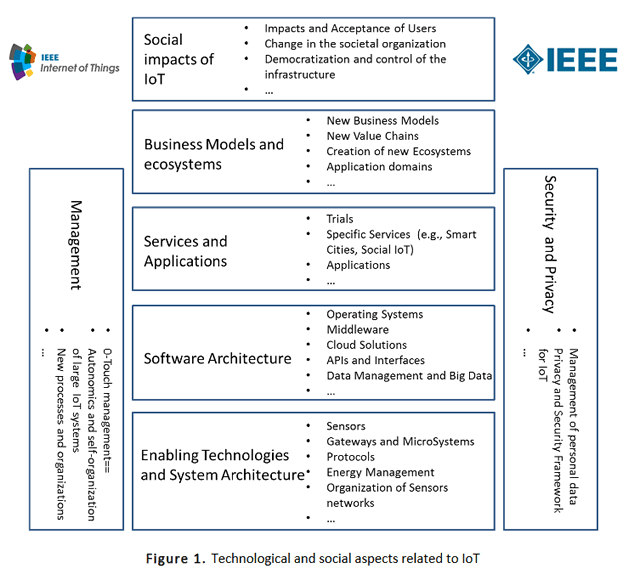
More Internet of Things definitions
Definition by the Internet Society
The term Internet of Things generally refers to scenarios where network connectivity and computing capability extends to objects, sensors and everyday items not normally considered computers, allowing these devices to generate, exchange and consume data with minimal human intervention. There is, however, no single, universal definition.
Definition ITU-T Y.4000/Y.2060 (06/2012)
A global infrastructure for the information society, enabling advanced services by interconnecting (physical and virtual) things based on existing and evolving interoperable information and communication technologies.
NOTE 1 – Through the exploitation of identification, data capture, processing and communication capabilities, the IoT makes full use of things to offer services to all kinds of applications, whilst ensuring that cybersecurity and privacy requirements are fulfilled.
NOTE 2 – From a broader perspective, the IoT can be perceived as a vision with technological and societal implications.
The concept to allow Internet-based communications to happen between physical objects, sensors, and controllers. The network of physical objects—devices, vehicles, buildings, and other items that are embedded with electronics, software, sensors, and network connectivity, which enables these objects to collect and exchange data.
Beyond IoT definitions: IoT-related terms and acronyms
We had the Internet of Things, the Consumer IoT and the Industrial Internet of Things. We looked at M2M and the roots of IoT and gave quite some perspective and a list of Internet of Things definitions. Yet, what about all those other terms we mentioned in a scope of IoT?
The Industrial Internet
A term you might have heard is the Industrial Internet, period. So, not the Industrial Internet of Things we’ve mentioned earlier.
The Industrial Internet is a term that was first used by GE, a big player in the industry and founder of the Industrial Internet Consortium. The definition of the Industrial Internet by GE: “the convergence of the global industrial system with the power of advanced computing, analytics, low-cost sensing and new levels of connectivity permitted by the internet”. So, it’s a bit more than the Industrial Internet of Things but IIoT quite obviously plays a key role in it.
IoE – IoT definition in the scope of the Internet of Everything
We’ve mentioned the Internet of Everything or IoE before. This is a term coined by Cisco that wants to go beyond the connected things aspect and also, among others, includes people and processes in the equation.
We wrote a pretty in-depth overview of the Internet of Everything. The definition of IoE has changed somewhat over the years but here is the definition of the Internet of Everything by Cisco: “The Internet of Everything (IoE) brings together people, process, data, and things to make networked connections more relevant and valuable than ever before-turning information into actions that create new capabilities, richer experiences, and unprecedented economic opportunity for businesses, individuals, and countries”. As mentioned: since give or take 2015-2016 Cisco stopped using the term IoE but quite some people are still using it since it has this somewhat broader perspective.
Cyber-physical systems and Industry 4.0
Another term is Industry 4.0 (and yes, it has an acronym too: 4IR). Although it is more than about the (Industrial) Internet of Things and has more in common with GE’s Industrial Internet, the Internet of Things plays a major role in it.
A building block of Industry 4.0 are the so-called cyber-physical systems (hence, the notion of cyber-physical convergence in Industry 4.0) and here many people say it is the same as the Industrial Internet of Things. However, it is not, even if it increasingly used interchangeably with Industrial IoT.
Industry 4.0, just like the Industrial Internet comes from the industrial market but, whereas the latter was coined by GE, Industry 4.0 comes from the German industry.
We defined Industry 4.0 in two ways. Here is one of our Industry 4.0 definitions: “The information-intensive transformation of manufacturing in a connected environment of data, people, processes, services, systems and production assets with the generation, leverage and utilization of actionable information as a way and means to realize the smart factory and new manufacturing ecosystems”. Note: there is also a concept called Industry 5.0 that looks more at the human aspect, including the future of work in a machine age.
More about Industry 4.0, Industry 4.0 definitions (including a list of Industry 4.0 definitions of others) and the definition of cyber-physical systems via the button below.
The Internet of Services (IoS)
Remember how many are moving away from the term Internet of Things as it focuses to much on the things and technologies?
Here is a reality of the Internet of Things (in fact it’s also an IoT trend): in the end what matters are the services. Moreover, companies use the Internet of Things to deploy new services and to move to as-a-service models.
That’s where the Internet of Services comes in. The term Internet of Services is mainly used in a context of Industry 4.0 and the Industrial Internet but it certainly goes for other areas too, as in the end the outcome of an IoT project or even consumer application is a service.
The term Internet of Services has been used by several organizations but sometimes in slightly different contexts. The EU uses it, German Industry 4.0 pioneer SAP uses it, research companies use it and the Institute of Electrical and Electronics Engineers (IEEE) has published a paper mentioning it.
Yet, none of them really defined the term. However, we’re sure you get the meaning.
The Internet of Robotic Things
Heard about the Internet of Robotic Things (IoRT)? If you didn’t now you have.
The term Internet of Robotic Things was coined by ABI Research. It’s more than a buzzword and it shows how views on what the Internet of Things is and can do evolve.
All too often we look at the possibilities of the Internet of Things from this rather passive perspective where data from physical objects enable services, insights and so forth.
Although data is critical and we’ve mentioned it a loT and although all these services, insights and so on have tremendous possibilities, there is more. IoT is not a one-way street, let’s be clear. However, so far we didn’t use IoT components and analytical functions, as well as integration possibilities with other systems, enabling physical devices to physically and (semi-)autonomously act THAT much. Well, the Internet of Robotic Things is about these aspects in a context of robots (e.g. the robotic platforms Amazon uses in its logistics) and cobots.
ABI Research defined IoRT as follows: the incorporation of the robotics aspect into the wider IoT.
More Internet of X terms
There are plenty of other variations on the same themes we’ve defined here. The Internet of Things, Data and Services (IoTDS) is a typical term of Industry 4.0. Some people talk about the Internet of Medical Things (IoMT) or the Internet of Healthcare Things (IoHT), some talk about the Internet of Things and Services (IoTS) and an industrial company, ABB Robotics, coined a term, Internet of Things, Services and People (IoTSP).
And there even more than the ones we mentioned. Believe us: there will pop up more new terms as the Internet of Things matures and keeps growing (faster and faster) in practice.
As usual, it’s not that much all the terms, let alone technologies that matter, it’s how and why the Internet of Things as that big umbrella term is used in practice. And then “it” just becomes part of a broader reality, both with regards to the bigger technology picture and the bigger use case and usage picture.
Top image: Shutterstock – Copyright: nitsawan katerattanakul – All other images are the property of their respective mentioned owners.

